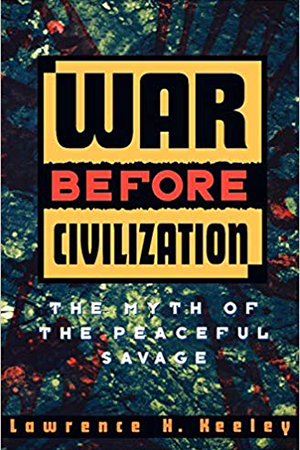
Anthropology and ethnography are definitely not areas about which I know much, so it is hard for me to tell where this book fits into the professional literature. It is a hybrid—a book by a professional anthropologist, meant largely for a popular audience, but not written in a popular style. It is, however, a book that appears to have had a very significant, if not generally acknowledged, impact on popular culture, in that it destroyed the idea that primitive peoples were peaceful, and established the opposite. That is, it established that every group of pre-civilized human people for tens of thousands of years, from small bands of hunter-gatherers through organized chiefdoms, engaged in continuous horrendous violence.
My general understanding is that any normal person, by which I mean someone other than an ideological hack employed at a university because that’s the only place he could be employed, or an aging hippie who thinks that American Indians spent their time communing silently with nature rather than running buffalo herds off cliffs, understands and completely agrees that primitive peoples were extremely violent, to a degree much greater even than modern people during the great wars of the 20th Century. However, this is a very recent realization, and flows basically from this book.
Keeley documents in extensive detail that prior to the late 1980s, and accelerating after World War II, anthropologists and ethnographers blithely assumed both that primitive societies either did not engage in any conflict, or to the extent they did, did so in ritualized fashion with extremely low injury and body counts. Keeley then demonstrates that all archaeological evidence proves the exact contrary, as does much, if not all, ethnographical evidence.
This comports with common sense, of course—why would primitive peoples be peaceful? It sounds stupid now to say that they’re peaceful, to most people, because as far as I can tell the lessons of this book and subsequent scholarship are accepted without argument. But it was only recently that, for example, all academics would make silly arguments like “that man is only buried with all those axes because he chopped a lot of trees” and “that big fence is a purely symbolic sign meaning ‘Keep Out’ ” (leaving aside the bodies, carrying babies, with arrows in their back under the burned remains of the fence). Or, my favorite, academics apparently maintained with a straight face that primitive tribes like the Yananamo were entirely peaceful, until one day the Europeans showed up and they immediately started killing each other because of the talismanic evil qualities of white people (or something like that).
Of course, ideology driving anthropology is nothing new. Witness the attempts to suppress study of Kennewick Man and the shrill insistence that the Clovis culture were the first peoples in the Americas. What interests me is that the impact of this book was so great, presumably because there was no evidence at all for the once-dominant academic and popular consensus. (I wonder what other academic consensus today might be proved wrong in the future?)
Keeley spends quite a bit of time analyzing the causes of primitive war as well. There are some interesting conclusions, among them that trade increases, rather that decreases, the chances of war. There is a brief, but very interesting, analysis of how American Indians engaged in constant warfare with Europeans while Canadian Indians, due to a different approach by the Canadian government, did not. The book is fairly dry, though, and ends up a bit oddly with some rambling about the need for one world government. It is also fairly short, and so being dry doesn’t really hurt it.
